Chinese Gold from the Collection of Robert Hatfield Ellsworth at Christie's New York, 26 March 2010
Lot 1292. A rare gold funerary mask, Liao dynasty (907-1125); 8 in. (20.3 cm.) high, Wt. 103.3 g. Estimate USD 100,000 - USD 150,000. Price realised USD 146,500. © Christie's Image Ltd 2010.
Worked from thin gold sheet, with a decorative border stamped at the outer edge, the sheet crimped over the mouth, the nose, ears, eyes and brows which are incised with hair markings, as is a mustache above the mouth, with creases and wrinkles in the gold, the stamped design of the border also seen on two 'ribbons' attached to the back edges just above the ears and attached by four narrow straps of gold to a central circular medallion with stamped decoration, a bead center and outer bead border, four further straps attached to the back edge above the forehead also attached to the medallion to form a 'net' that would have fit over the top of the head, box.
Provenance: Acquired in Hong Kong in the 1980s.
Note: During the Eastern Zhou period (770-256 BC) jade was used to cover the the faces of deceased members of the elite in China, a practice which continued into the Han dynasty (206 BC-AD 202), and then appears to have ceased. Archaeological evidence shows that burial masks were in use in areas west of China from the second to the eighth century, which may have been the inspiration for the use of funerary masks of different metals during the Liao dynasty (907-1125). Excavations of Liao tombs have revealed masks made of copper, bronze, gilded bronze, silver, and the discovery in 2003 of the Liao dynasty tomb of the Princess of Chen and her husband, Xiao Shaoju, provided archaeological evidence of burial masks being made from gold sheet. The status of the deceased appears to have dictated which metal was used. The shape, size and details of the individualized masks also varied.
Two gold funerary masks of a type similar to the present example are illustrated in Chinesisches Gold und Silber: Die Sammlung Pierre Uldry, Museum Reitberg, Zürich, 1994, pp. 212-3, nos. 239 and 241, as well as a similar 'net' of eight narrow straps radiating from a central circular medallion. Another was sold at Sotheby's, New York, 9 December 1987, lot 155; and two along with a 'net' were sold in our New York rooms, 1 June 1988, lot 34.
Lot 1287. A rare gold fitting with glass inlay, Warring States period, 5th-3rd century BC; 3 in. (7.6 cm.) long, ring 1½ in. (3.9 cm.) diam., Wt. 90.8 g. Estimate USD 30,000 - USD 40,000. Price realised USD 50,000. © Christie's Image Ltd 2010.
The tubular fitting terminating in a dragon head with ridged snout and a scrolling mane on either side trailing backwards from the curved brows set above glass-inlaid eyes, with a small blue glass bead on the top of the head and a loose, twisted ring pendent from the mouth, the remains of an iron core visible at the opposite end which is encircled by a double bow-string band.
Provenance: Alice Boney, Japan, 1953.
Note: A pair of gold dragon-head fittings of this type without loose rings, excavated between 1974-78 from the 4th century BC Warring States tomb of King Cuo, at Lingshou, the ancient capital of the State of Zhongshan in present-day Pingshan county, in Hebei province, is illustrated by Han Wei and Christian Deydier, Ancient Chinese Gold, Paris, 2001, p. 53, no. 87, where they are described as chariot fittings. The eyes of the dragons are in silver which would have surrounded pupils inlaid in stones or glass, similar to the glass inlaid pupils of the present dragon head. The sides and front of the mouth of the excavated fittings are hollow indicating that they may have suspended a ring of some kind. See, also, the pair of gold and silver-inlaid bronze fittings of this type with dragon-head terminals dated 4th-3rd century BC illustrated by C. Delacour, De bronzes, d'or et d'argent: Arts somptuaires de la Chine, Musée Guimet, Paris, 2001, pp. 145-7. A loop at the front of the jaws is formed by the curved body of a raptor.
Lot 1282. A very rare turquoise-inlaid gold tubular fitting, Western Han dynasty (206 BC-AD 8); 4½ in. (11.5 cm.) long ,Wt. 106.8 g. Estimate USD 20,000 - USD 30,000. Price realised USD 47,500. © Christie's Image Ltd 2010.
Probably from Shandong province, the heavily cast fitting encircled by five ribs with narrow raised borders and inlaid around the sides with turquoise chips, those at the ends and in the middle of triangular shape and those between in the shape of small cabochons, with traces of cinnabar on the interior.
Provenance: Alice Boney, Japan, 1960s.
Note: No other gold fitting of this type appears to have been published. Based on the shape it might have been part of a handle. The use of gold and turquoise inlay, as well as the simple, elegant shape, appear to relate it to gold pieces of this date from Northern China.
Lot 1289. Two rare gold monster-mask fittings, Eastern Zhou dynasty (770-256 BC); 2¾ and 2 7/8 in. (7 and 7.3 cm.) wide Wt. 35.7 and 36.7 g. Estimate USD 15,000 - USD 20,000. Price realised USD 32,500. © Christie's Image Ltd 2010.
Each cast in high relief as a taotie mask with incised and granulated decoration, one more in openwork with the short curved bodies of two dragons flanking the eyes below curved horns and outward-curved projections, the other, broader mask with curved tusks ending in pointed tips projecting either side of the nose.
Provenance: A.W. Bahr Collection, Weybridge, England.
Edna Bahr, Connecticut, late 1960s.
Note: A group of similar cast gold masks of varying sizes (2.9-8.3 cm. wide) dated to the Warring States period (475-221 BC) are illustrated in Celestial Creations: Art of the Chinese Goldsmith - The Cheng Xun Tang Collection - I- , Art Museum, Institute of Chinese Studies, The Chinese University of Hong Kong, 2007, p. 65, no. A30. The authors note that similar gold plaques have been recovered from tombs of the Spring and Autumn to Warring States periods in Baoji and Fengxiang, Shaanxi province.
Lot 1290. A rare pair of gold foil-decorated bronze harness fittings, Warring States period, 5th-4th century BC; 2 in. (5 cm.) across Wt. 87.1 and 88.8 g. Estimate USD 25,000 - USD 35,000. Price realised USD 32,500. © Christie's Image Ltd 2010.
Each comprised of a domed bronze ring from which project three posts surmounted bytaotie masks covered in gold foil, the outward-facing masks with protruding tongue, small nose, bulbous eyes below small ears and curved horns, with areas of beaded detailing, with malachite green and azurite encrustation.
Provenance: Alice Boney, New York, 1953.
Note: Compare the similar harness fitting, illustrated by B. Gyllensvärd, Chinese Gold and Silver in the Carl Kempe Collection, Stockholm, 1953, pp. 64-5, no. 3, later sold at Sotheby's, London, 14 May 2008, lot 12. A similar fitting was excavated from a large pit filled with the remains of chariots and horses at a Warring States site at Fengxiang Doufu village in Shaanxi province. A pair of fittings of similar type, but with silver masks surmounting each post, excavated 1974-78 from the tomb of King Cuo (r. 327-313 BC), State of Zhongshan, in Lingshou, present-day Pingshan county, Hebei province, is illustrated by Han Wei and Christian Deydier,Ancient Chinese Gold, Paris, 2001, p. 53, no. 86.
Stylistically the masks are similar to late Spring and Autumn period (5th-4th century BC) masks cast at the Houma foundry in southern Shanxi province, as evidenced by molds excavated at the foundry site, 1957-1965. Such a mold is illustrated in Art of the Houma Foundry, Institute of Archaeology of Shanxi Province, Princeton, New Jersey, 1996, p. 168, no. 180.
Lot 1286. A rare pair of small gold circular fittings, Late Eastern Han-Six Dynasties period, 2nd-4th century; 1 and 1 1/16 in. (2.5 and 2.7 cm.) high Wt. 31.3 and 28.3 g. Estimate USD 8,000 - USD 12,000. Price realised USD 31,250. © Christie's Image Ltd 2010.
Each slightly domed circular cap stamped with a dogtooth band around the sides and surmounted by a snarling chimera standing in a threatening position with head slightly turned, with long slender beard, V-shaped mane, wings sweeping back from the front haunches and a slender tail flicked to one side.
Note: A very similar fitting, dated late Eastern Han or Six Dynasties, 2nd-4th century AD, is illustrated in Chinesisches Gold und Silber: Die Sammlung Pierre Uldry, Reitberg Museum, Zürich, 1994, p. 134, no. 109.
Lot 1298. A rare gold filigree hair ornament, Ming dynasty (1368-1644); 4¾ in. (12 cm.) wide, 4 7/8 in. (12.4 cm.) deep, Wt. 97.9 g.stimate USD 15,000 - USD 25,000. Price realised USD 27,500. © Christie's Image Ltd 2010.
Made to cover a topknot and in the shape of a domed oval with parallel 'ribs' of twisted and plain fine gold wire interrupted by a horizontal band of florets across the top, with flower sprigs in the corners and applied with two flower heads with recesses for inlay, with flared openwork projections in front, to the sides and in back where two 'ribbons' extend from the rim, all filled with foliate filigree; with two gold hair pins that are inserted in either end at the bottom of the band of florets, box.
Provenance: A.W. Bahr Collection, Weybridge, England.
Edna Bahr, Connecticut, late 1960s.
Note: Gold hair ornaments of this type, meant to be used as a cap for a man's topknot, appear to be quite rare. An excavated example with hardstone inlay, dated to the Ming dynasty, is illustrated in Zhongguo Wenwu Jingjin Daquan - Jin Yin Yu Shi Juan, Hong Kong, 1994, p. 149, no. 174. Another, also dated to the Ming dynasty, is illustrated by Emma C. Bunker and Julia M. White et al., Adornment for the Body and Soul: Ancient Chinese Ornaments from the Mengdiexuan Collection, The University Museum and Art Gallery, The University of Hong Kong, Hong Kong, 1999, no. 138.
Lot 1285. A rare small gold openwork ornament, 5th-4th century BC; 2 5/8 in. (6.7 cm.) long ,Wt. 46.2 g. Estimate USD 8,000 - USD 12,000. Price realised USD 25,000. © Christie's Image Ltd 2010.
Well cast as two battling animals, one a large dragon with taotie mask head and two rows of beading following the sinuous lines of the body which is entwined with and being bitten by a mongoose-like animal with equally sinuous body and short whiskers sprouting from beside the small nose, also with small ears and two narrow bands of granulation extending from behind the front legs to the tail, the reverse concave.
Provenance: A.W. Bahr Collection, Weybridge, England.
Edna Bahr, Connecticut, late 1960s.
Note: This elegant ornament is stylistically similar in its use of interlaced bodies decorated with beaded bands to that of a gold ornament of comparable size dated to the 5th-4th century BC, illustrated in Chinesisches Gold und Silber: Die Sammlung Pierre Uldry, Museum Rietberg, Zürich, 1994, p. 74, no. 13.
Lot 1291. A group of rare gold plaques, Western Zhou Dynasty, Qin culture, circa 9th-8th century BC; 13 7/8, 4 5/8 and 4¾ in. (34.7, 11.8 and 12 cm.) long, Wt. 178.8, 55.5, 79.5 and 64.7 g. Estimate USD 30,000 - USD 50,000. Price realised USD 25,000. © Christie's Image Ltd 2010.
Made from thick hammered gold sheet and with chased decoration, the largest of elongated arrow shape with elongated C-scrolls and pierced near the edges of the upper section for attachment; two of the plaques of slightly rhomboid shape with short extensions at two opposing corners, with hooked scrolls surrounding an oblong 'eye', the corners pierced; the fourth of rectangular shape with one barbed edge, with a band of conforming shape bordering two scale-shaped motifs, with double piercings at two corners, box.
Provenance: Acquired in Hong Kong in the 1980s.
Note: These rare gold sheet plaques are very similar to a group illustrated by Han Wei and Christian Deydier, Ancient Chinese Gold, Paris, 2001, pp. 28-31, pls. 20-25, which are dated Western Zhou dynasty, Qin culture, and are in a private collection. The authors discuss the discovery of a tomb in the east of Dabaozi mountain in Li county, Gansu province. The tomb was attributed to a nobleman of the state of Qin, possibly the Qin Marquis Zhong (845-822 BC), or his son the Qin Duke of Zhuang (822-778 BC), and contained gold sheet and gold objects, including "a set of gold sheets of fish-scale-like shape, square but with round, rectangular angles etc. and adorned with a lip design and C-shaped clouds".
Lot 1295. A pair of gold Makara-form earrings, Liao dynasty (907-1125). Earrings 1½ in. (3.8 cm.) high including hook; buttons ¾ in. (1.9 cm.) with loop, Wt. earrings 10.6 g.; buttons 3.2 - 3.6 g. Estimate USD 6,000 - USD 8,000. Price realised USD 12,500. © Christie's Image Ltd 2010.
Each in the form of a hollow dragon/fish formed by two pieces worked in repoussé in high relief and then joined together, each finely detailed with fins and scales, with a bifurcated crest on top of the head opposite a flower bud projecting below the mouth;together with five small hollow globular buttons, Liao dynasty, with chased decoration around the sides and attached to a small loop, fitted box.
Provenance: Acquired in the 1980s.
Note: A single gold earring of this shape excavated in 1992 from a Liao dynasty tomb in Inner Mongolia is illustrated by Yu Jianshe, ed., Essence of Chifeng Historical Relics Series, 2006, p. 47, no. CJ031. See, also, the similar earring of slightly larger size (5.7 cm.) dated to the Liao dynasty illustrated by Julia M. White and Emma C. Bunker, Adornment for Eternity: Status and Rank in Chinese Ornament, Denver Art Museum, 1994, p. 158, no. 71.
Lor 1283. A rare turquoise-inlaid gold circular applique, Western Han dynasty (206 BC-AD 8); 1 13/16 in. (4.5 cm.) diam., Wt. 29.0 g. Estimate USD 8,000 - USD 12,000. Price realised USD 10,625. © Christie's Image Ltd 2010.
Cast with the simplified heads of three kulan with turquoise-inlaid eyes and laid-back ears surrounding a domed center inlaid with a turquoise cabochon, the narrow outer border with diagonal striations above each kulan head, starting at the eye and continuing along the neck to represent the mane, with three tiny angular loops projecting from the rim on the hollow back where the underside of the turquoise inlay can be seen to be held in place by tiny tabs.
Provenance: Alice Boney, Japan, 1960s.
Note: The three heads on this rare plaque, with their long ears and striated manes are probably those of kulan, a type of wild ass which roamed over North China in ancient times. A similar gold roundel (4.8 cm. diam.), also cast with the heads of three kulan and inlaid in a similar manner with turquoise, is illustrated by Viktor Griessmaier, Sammlung Baron Eduard Von Der Heydt, Vienna, 1936, no. 67. The use of these heads as a decorative motif and their simplicity of design relate the appliques to pieces made in northern China, possibly Northeast China, for nomadic people.
Lot 1294. A group of gold harpins, Song dynasty (960-1279); 2 3/8 to 6¾ in. (6 to 17 cm.) long Wt. 17.5, 16.8, 10.6, 8.1, 7.7 and 8.7 g. Estimate USD 8,000 - USD 12,000. Price realised USD 7,500. © Christie's Image Ltd 2010.
All made of sheet gold wrapped into a tapering cylindrical pin, with repoussé relief decoration at the top below an attached flower-form cap: comprising a long pair relief-decorated with a pair of ducks in flight above a lotus pond below the chrysanthemum flower cap; the other long pin and the pair of shorter double pins with flower stems below the peony-form caps; together with the upper section of a double hairpin decorated with flowers.
Provenance: Acquired in Hong Kong in the 1980s.
Note: Compare the gold hairpins of this type also dated to the Song dynasty illustrated by Julia M. White and Emma C. Bunker, Adornment for Eternity: Status and Rank in Chinese Ornament, Denver Art Museum, 1994, pp. 183-4, nos. 95 and 96. See, also, a single similar example illustrated in Chinesisches Gold und Silber: Die Sammlung Pierre Uldry, Museum Reitberg, Zürich, 1994, p. 242, no. 292.
Lot 1296. A pair of gold flat 'cash'-form appliques, Song-Ming dynasty (10th-17th century); 2 7/16 in. (6.2 cm.) diam., Wt. 18.7 and 17.4 g. Estimate USD 4,000 - USD 6,000. Price realised USD 5,250. © Christie's Image Ltd 2010.
Each of beaten gold sheet with a square aperture in the center, one side chased and divided into four quadrants by bands of cloud scroll alternately enclosing cranes and clouds reserved on a fine punched ground, with further cloud scroll in the outer border, box.
Provenance: Acquired in Hong Kong in the 1980s.
Note: Two gold discs of this type chased with characters within the quadrants, dated to the Song dynasty, are illustrated in Chinesisches Gold und Silber: Die Sammlung Pierre Uldry, Reitberg Museum, Zürich, 1994, p. 226, nos. 264 and 265.
Lot 1284. A pair of gold foil-decorated bronze fittings, Warring States period, 4th century BC; ¾ in. (4.5 cm.) across, Wt. 69.0 and 68.4 g. Estimate USD 6,000 - USD 8,000. Price realised USD 5,000. © Christie's Image Ltd 2010.
Each a loop cast on top in high relief with the granulated snake-like bodies of entwined dragons, with a rectangular loop below and an oblong opening in front from which rises a short post cast on top in the shape of a taotie mask overlaid with thin gold sheet pressed over the taotie mask to form the hook, with extensive green encrustation.
Provenance: Alice Boney, Japan, 1953.
Note: The gold masks are stylistically similar to those seen on circular bronze fittings such as the example from the Ellsworth Collection, lot 1290; the example illustrated in Chinesisches Gold und Silber: Die Sammlung Pierre Uldry, Museum Reitberg, Zürich, 1994, p. 74, no. 12; and one illustrated by B. Gyllensvärd, Chinese Gold & Silver in the Carl Kempe Collection, Stockholm, 1953, pp. 64-5, no. 3.
Lot 1297. A pair of gold earrings, Ming dynasty (1368-1644); 1½ in. (3.8 cm.) long Wt. 2.9 and 2.9 g. Estimate USD 4,000 - USD 6,000. Price realised USD 3,500. © Christie's Image Ltd 2010.
Each made from a thin piece of sheet gold partially chased with a design of a boy flanked by melons seated on a stippled ground between flowers, the chased section wrapped around to form the bottom of the earring and the remainder of the sheet crimped and rolled to form the slender arched hook.
Provenance: Acquired in Hong Kong in the 1980s.
Note: Another similarly constructed gold earring of Ming date also chased with a boy, but surrounded by flowers rather than melons, is illustrated by Julia M. White and Emma C. Bunker, Adornment for Eternity: Status and Rank in Chinese Ornament, Denver Art Museum, 1994, p. 195, no. 108.
Lot 1293. A gold hairpin, Yuan-Ming dynasty, 13th-17th century; 5 1/8 in. (13 cm.) long, Wt. 5.8 g. Estimate USD 2,000 - USD 3,000. Price realised USD 3,000. © Christie's Image Ltd 2010.
The flat pin made from thin beaten gold sheet tapering towards one end and cut at the other with four slender stamen that rise above the applied, chased peony flower, the pin finely stippled on the front with a fine scroll and on the back with a three-character inscription that may be read, Qiong Xi Gu, fitted box.
Provenance: Acquired in Hong Kong in the 1980s.
Note: The inscription, Qiong Xi Gu, may refer to a specific person. The decoration of a finely stippled scroll can also be seen on the flat prong of a gold hairpin unearthed from a Ming dynasty tomb outside Zhonghu Gate, Nanjing, illustrated in Jewelry and Costumes of Ming Dynasty, Nanjing Municipal Museum, 2000, p. 89. Another gold hairpin excavated from a Ming dynasty tomb outside Nanjing illustrated ibid., p. 78, also has a separately made flower attached to the flat pin.
Christie's. Fine Chinese Ceramics and Works of Art Including Property from the Arthur M. Sackler Collections, New York, 26 March 2010.

/https%3A%2F%2Fprofilepics.canalblog.com%2Fprofilepics%2F1%2F0%2F100183.jpg)
/https%3A%2F%2Fstorage.canalblog.com%2F03%2F02%2F119589%2F96711876_o.jpg)
/https%3A%2F%2Fstorage.canalblog.com%2F11%2F31%2F119589%2F94773502_o.jpg)
/https%3A%2F%2Fstorage.canalblog.com%2F20%2F83%2F119589%2F94772815_o.jpg)
/https%3A%2F%2Fstorage.canalblog.com%2F26%2F72%2F119589%2F75604929_o.jpg)
/https%3A%2F%2Fstorage.canalblog.com%2F59%2F60%2F119589%2F26458628_o.jpg)






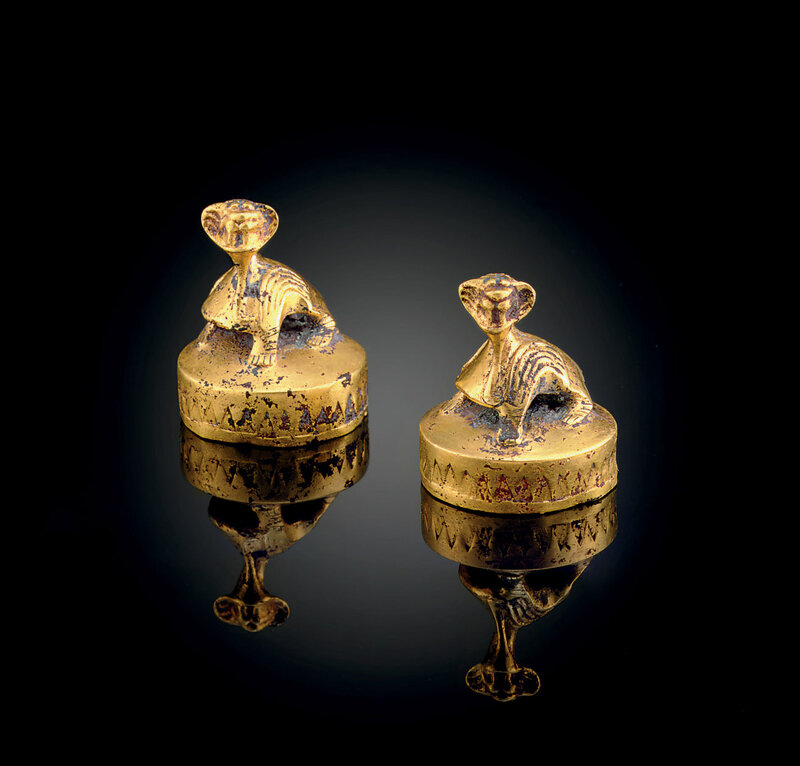
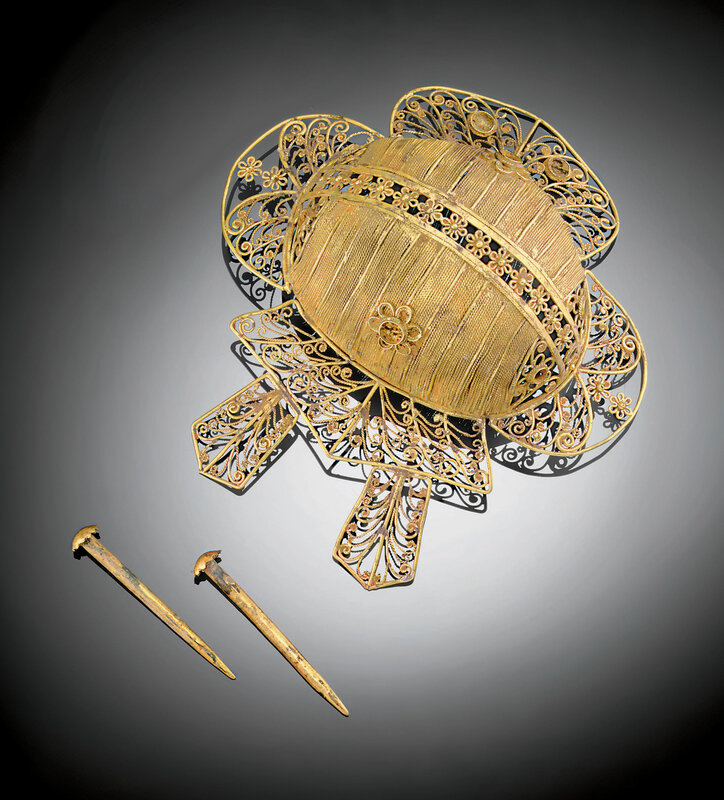




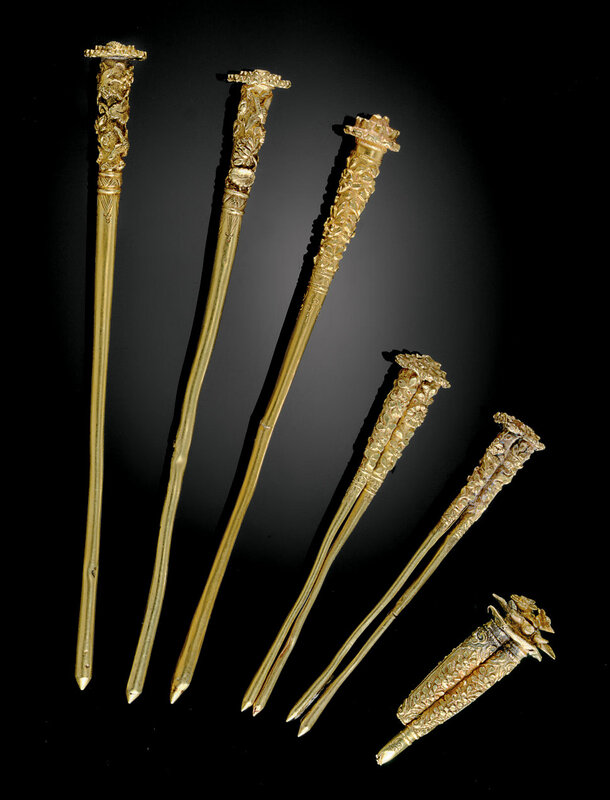


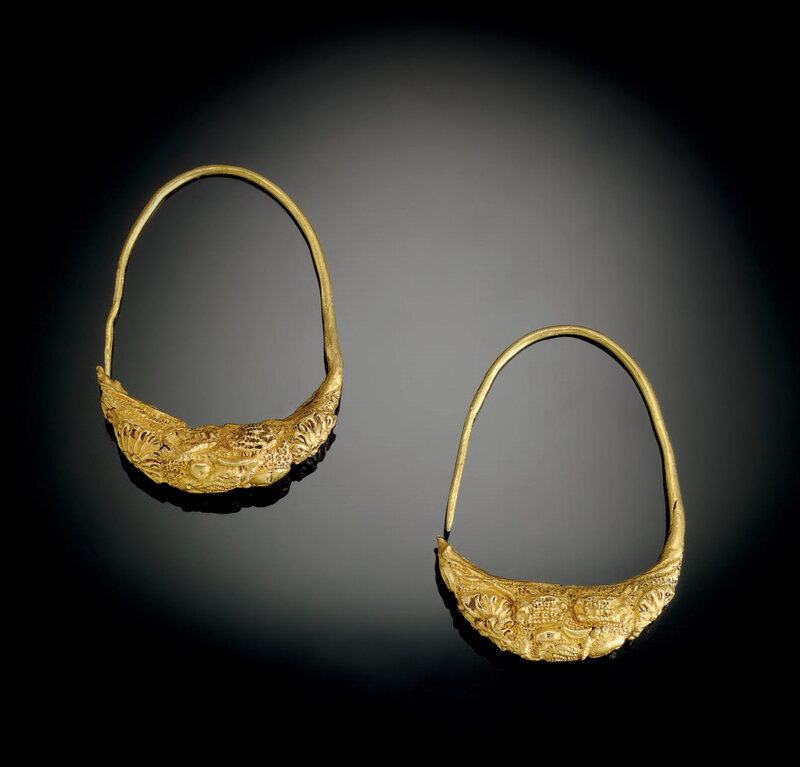
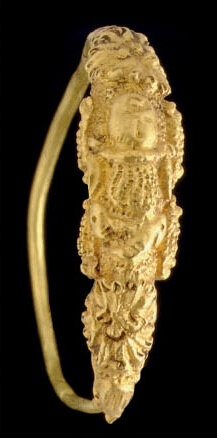



/image%2F1371349%2F20240415%2Fob_308536_436292768-1650079115762101-83406494688.jpg)
/image%2F1371349%2F20240408%2Fob_b3fc19_435359290-1647758335994179-79867038222.jpg)
/image%2F1371349%2F20240406%2Fob_9e792c_435377691-1644764672960212-80619555723.jpg)
/image%2F1371349%2F20240406%2Fob_d1f50a_436272281-1646702666099746-69647680342.jpg)